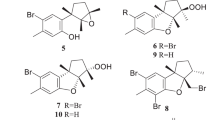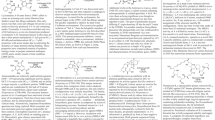Abstract
In the past few decades, marine natural products bioprospecting has yielded a considerable number of drug candidates. Two marine natural products have recently been admitted as new drugs: Prialt (also known as ziconotide) as a potent analgesic for severe chronic pain and Yondelis (known also as trabectedin or E-743) as antitumor agent for the treatment of advanced soft tissue sarcoma. In this protocol, methods for bioactivity-guided isolation, purification and identification of secondary metabolites from marine invertebrates such as sponges, tunicates, soft corals and crinoids are discussed. To achieve this goal, solvent extraction of usually freeze-dried sample of marine organisms is performed. Next, the extract obtained is fractionated by liquid–liquid partitioning followed by various chromatographic separation techniques including thin layer chromatography, vacuum liquid chromatography, column chromatography (CC) and preparative high-performance reversed-phase liquid chromatography. Isolation of bioactive secondary metabolites is usually monitored by bioactivity assays, e.g., antioxidant (2,2-diphenyl-1-picryl hydrazyl) and cytotoxicity (microculture tetrazolium) activities that ultimately yield the active principles. Special care should be taken when performing isolation procedures adapted to the physical and chemical characteristics of the compounds isolated, particularly their lipo- or hydrophilic characters. Examples of isolation of compounds of different polarities from extracts of various marine invertebrates will be presented in this protocol. Structure elucidation is achieved using recent spectroscopic techniques, especially 2D NMR and mass spectrometry analysis.
This is a preview of subscription content, access via your institution
Access options
Subscribe to this journal
Receive 12 print issues and online access
$259.00 per year
only $21.58 per issue
Buy this article
- Purchase on Springer Link
- Instant access to full article PDF
Prices may be subject to local taxes which are calculated during checkout

















Similar content being viewed by others
References
Schupp, P., Eder, C., Paul, V. & Proksch, P. Distribution of secondary metabolites in the sponge Oceanapia sp. and its ecological implications. Marine Biol. 135, 573–580 (1999).
Epifanio, R.D.A., Martins, D.L., Villaça, R. & Gabriel, R. Chemical defenses against fish predation in three Brazilian octocorals: 11β,12β-epoxypukalide as a feeding deterrent in Phyllogorgia dilatata. J. Chem. Ecol. 25, 2255–2265 (1999).
Epifanio, R.D.A., Gabriel, R., Martins, D.L. & Muricy, G. The sesterterpene variabilin as a fish-predation deterrent in the western Atlantic sponge Ircinia strobilina. J. Chem. Ecol. 25, 2247–2254 (1999).
Kicklighter, C.E., Kubanek, J. & Hay, M.E. Do brominated natural products defend marine worms from consumers? Some do, most don't. Limnol. Oceanorg. 49, 430–441 (2004).
Bhakuni, D.S. & Rawat, D.S. Bioactive Marine Natural Products, 26–77 (Springer-Anamaya, New York, New Delhi, 2005).
Proksch, P., Edrada, R.A. & Ebel, R. Drugs from the seas—current status and microbiological implications. Appl. Microbiol. Biotechnol. 59, 125–134 (2002).
Newman, D.J., Cragg, G.M. & Sander, K.M. The influence of natural products upon drug discovery. Nat. Prod. Rep. 17, 215–234 (2000).
König, G.M. & Wright, A.D. Marine natural products research: current directions and future potential. Planta Medica 62, 193–211 (1996).
Claeson, P. & Bohlin, L. Some aspects of bioassay methods in natural-product research aimed at drug lead discovery. Trends. Biotech. 15, 245–246 (1997).
Pawlik, J.R. Marine invertebrate chemical defenses. Chem. Rev. 93, 1911–1922 (1993).
Huang, X., Deng, Z., Zhu, X., van Ofwegen, L., Proksch, P. & Lin, W. Krempenes A–D: a series of unprecedented pregnane-type steroids from the marine soft coral Cladiella krempfi. Helv. Chim. Act. 89, 2020–2026 (2006).
Lee, N.K. & Kim, Y.H. New cytotoxic anthraquinones from the crinoid Ptilometra: 1′-deoxyrhodoptilometrin-6-O-sulfate and rhodoptilometrin-6-O-sulfate. Bull. Kor. Chem. Soc. 16, 1011–1013 (1995).
Ibrahim, S.R.M., Edrada-Ebel, R.A., Mohamed, G.A., Youssef, D.T.A., Wray, V. & Proksch, P. Callyaerin G, a new cytotoxic cyclic peptide from the marine sponge Callyspongia aerizusa. ARKIVOC XII, 164–171 (2008).
Pedpradab, S., Edrada, R.A., Ebel, R., Wray, V. & Proksch, P. New β-carboline alkaloids from the Andaman sea sponge Dragmacidon sp. J. Nat. Prod. 67, 2113–2116 (2004).
Schupp, P. et al. Eudistomins W and X, two new β-carbolines from the Micronesian tunicate Eudistoma sp. J. Nat. Prod. 66, 272–275 (2003).
Schupp, P., Proksch, P. & Wray, V. Further new staurosporine derivatives from the ascidian Eudistoma toealensis and its predatory flatworm Pseudoceros sp. J. Nat. Prod. 65, 295–298 (2002).
Hassan, W. et al. New imidazole alkaloids from the Indonesian sponge Leucetta chagosensis. J. Nat. Prod. 67, 817–822 (2004).
Fouad, M. et al. New steroidal saponins from the sponge Erylus lendenfeldi. ARKIVOC XIII, 17–27 (2004).
Shimizu, Y. Purification of water-soluble natural products. In Natural Products Isolation (ed. Cannell, J.P.) 329–342 (Humana Press, Totowa, New Jersey, USA, 1998).
Shimizu, Y. Bioactive marine natural products, with emphasis on handling of water-soluble compounds. J. Nat. Prod. 48, 223–235 (1985).
Wright, A.E. Isolation of marine natural products. In Natural Products Isolation (ed. Cannell, J.P.) 329–342 (Humana Press, Totowa, New Jersey, USA, 1998).
Mc Alpine, J.B. & Hochlowski, J.E. Isolation and purification of secondary metabolites. In The Discovery of Natural Products with Therapeutic Potential (ed. Gullo, V.P.) 349–388 (Butterworth-Heinemann, Boston, 1994).
Quinn, R.J. Chemistry of aqueous marine extracts: Isolation techniques. In Bioorganic Marine Chemistry Vol. 2 (ed. Scheuer, P.J.) 1 (Springer-Verlag, Berlin, Heidelberg, New York, 1988).
Riguera, R. Isolating bioactive compounds from marine organisms. J. Marine Biotechnol. 5, 187–193 (1997).
Thoms, C., Ebel, R. & Proksch, P. Activated chemical defense in Aplysina sponges revisited. J. Chem. Ecol. 32, 97–123 (2006).
Müller, W.E.G., Hanske, W., Maidhof, A. & Zahn, R.K. Influence of apurinic acid on programmed synthesis in different in vitro systems. Can. Res. 33, 2330–2337 (1973).
Michels, G. et al. Resveratrol induces apoptotic cell death in rat H4IIE hepatoma cells but necrosis in C6 glioma cells. Toxicol. 225, 173–182 (2006).
Chovolou, Y., Wätjen, W., Kampkötter, A. & Kahl, R. Downregulation of NF-kB activation in a H4IIE transfectant insensitive to doxorubicin-induced apoptosis. Toxicol. 232, 89–98 (2007).
Pelletier, S.W., Choksh, H.P. & Desai, H.K. Separation of diterenoid alkaloid mixtures using vacuum liquid chromatography. J. Nat. Prod. 49, 892–900 (1986).
Coll, J.C. & Bowden, B.F. The application of vacuum liquid chromatography to the separation of terpene mixtures. J. Nat. Prod. 49, 934–936 (1986).
Blunt, J.W. et al. Reverse phase flash chromatography: a method for the rapid partitioning of natural product extracts. J. Nat. Prod. 50, 290–292 (1987).
Murray, A.P., Rodriguez, S., Frontera, M.A., Tomas, M.A. & Mulet, M.C. Antioxidant metabolites from Limonium brasiliense (Boiss.) Kuntze. Z. Naturforsch. 59c, 477–480 (2004).
Carmichael, J., DeGraff, W.G., Gazdar, A.F., Minna, J.D. & Mitchell, J.B. Evaluation of a tetrazolium-based semiautomated colorimetric assay: assessment of radiosensitivity. Can. Res. 47, 943–946 (1987).
Ashour, M. et al. Kahalalide derivatives from the Indian Sacoglossan mollusk Elysia grandifolia. J. Nat. Prod. 69, 1547–1553 (2006).
Acknowledgements
We are indebted to Professor Dr. W.E.G. Müller (University of Mainz) and Dr. W. Waetjen (Heinrich-Heine-University, Duesseldorf) for performing cytotoxicity (MTT) assays. We also acknowledge Dr. P. Tommes (Heinrich-Heine University, Duesseldorf) for his help in measuring mass spectra and Dr. W. Peters (Heinrich-Heine University, Duesseldorf), as well as Dr. V. Wray (Helmholtz Centre for Infection Research, Braunschweig), for performing NMR measurements. We also acknowledge Professor Dr. Gerhard Bringmann, Institute for Organic Chemistry, University of Wuerzburg, for performing CD spectral analysis. Continued financial support of our studies on bioactive marine natural products by the BMBF (Germany) as well as by numerous other grant agencies (e.g., DFG, DAAD, MOST, Egyptian Government Scholarship and others) is gratefully acknowledged.
Author information
Authors and Affiliations
Corresponding author
Rights and permissions
About this article
Cite this article
Ebada, S., Edrada, R., Lin, W. et al. Methods for isolation, purification and structural elucidation of bioactive secondary metabolites from marine invertebrates. Nat Protoc 3, 1820–1831 (2008). https://doi.org/10.1038/nprot.2008.182
Published:
Issue Date:
DOI: https://doi.org/10.1038/nprot.2008.182
This article is cited by
-
Anti-fungal bioactive terpenoids in the bioenergy crop switchgrass (Panicum virgatum) may contribute to ecotype-specific microbiome composition
Communications Biology (2023)
-
Marine bioactive compounds as antibiofilm agent: a metabolomic approach
Archives of Microbiology (2023)
-
Metabolomics on the study of marine organisms
Metabolomics (2022)
-
Metabolomic study of soft corals from the Colombian Caribbean: PSYCHE and 1H-NMR comparative analysis
Scientific Reports (2020)
-
Marine sponges Sarcotragus foetidus, Xestospongia carbonaria and Spongia obscura constituents ameliorate IL-1 β and IL-6 in lipopolysaccharide-induced RAW 264.7 macrophages and carrageenan-induced oedema in rats
Inflammopharmacology (2020)
Comments
By submitting a comment you agree to abide by our Terms and Community Guidelines. If you find something abusive or that does not comply with our terms or guidelines please flag it as inappropriate.



